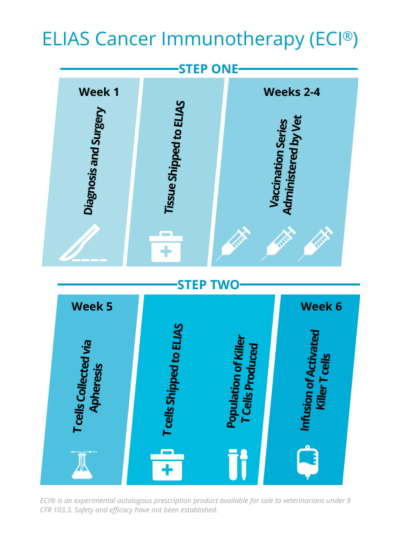The ELIAS Cancer Immunotherapy (ECI®) is an alternative treatment option to chemotherapy for certain types of canine cancer. ECI is a two-step sequential and interdependent protocol. Step 1 involves priming the patient’s immune system with a personalized vaccine that stimulates an immune response. Step 2 is the activation, expansion and reinfusion of the patient’s cancer antigen-specific T cells which can travel to and attack the cancer cells in the dog’s body.
We’re often asked if patients can receive only the vaccines, without T cell infusion. Both steps are essential and play different roles in treatment. Stimulating the immune system isn’t enough to eliminate cancer. The vaccine step primes the immune system to create T cells that can specifically recognize the cancer cells. In the second step of the treatment protocol, these T cells are collected from the blood, and then functionally activated and numerically expanded in the laboratory. Once these activated killer T cells are infused back into the patient, they can hunt down and kill cancer cells. It’s a 1-2 punch that produces more powerful results than either step can alone.

How does the T cell infusion work?
In the ECI treatment protocol, the T cell infusion is administered by the veterinary hospital one week after apheresis – a medical procedure which collects the patient’s T cells that were generated by the vaccine. (Learn more about how apheresis is used in veterinary medicine in this blog.) Here’s what happens during the infusion step of ECI:
- T cells are infused into the dog through an IV over 30-60 minutes.
- The patient remains in the hospital for 4-6 hours for observation.
- Provided the dog is doing well, he or she will be discharged that same day. It is vital the dog is allowed to rest quietly at home for the next few days in order to allow the immune system to begin doing its job to fight the cancer.
Is ECI safe?
Most dogs have mild symptoms following T cell infusion and they typically resolve within a day or so. All post-infusion adverse events reported in the clinical trial were characterized as mild to moderate (Grade 1-2 on the Veterinary Cooperative Oncology Group (VCOG) scale), except for one instance of Grade 3 lethargy.
In rare cases, a patient may experience a more pronounced immune reaction and may require additional medical intervention.
What happens to the dog after the T cell infusion?
Reactions are a likely occurrence any time the immune system is stimulated. Think about the last time you had a cold – in addition to the symptoms, you likely felt tired and a bit run down. That’s because your immune system was working hard to get rid of the virus.
The same is true with the T cell infusion in the ECI treatment protocol. The infusion triggers the immune system to go to work fighting cancer. Canine patients may experience nausea, lack of appetite, diarrhea, fever, or lethargy. These symptoms usually resolve within a day. Dogs should be kept calm, comfortable, and quiet for the next couple of days after the T cell infusion. Veterinarians overseeing treatment provide guidance to pet owners on post treatment care for patients under their medical supervision.
Learn more about the full ECI protocol on our website.
